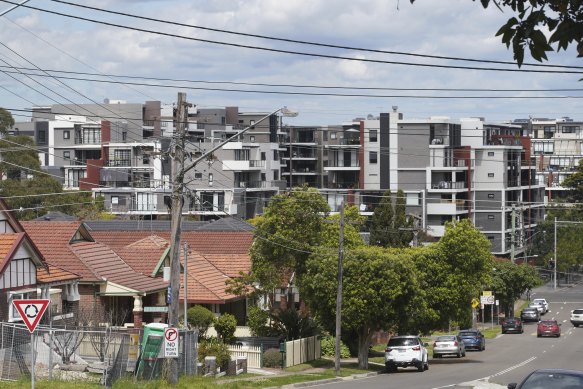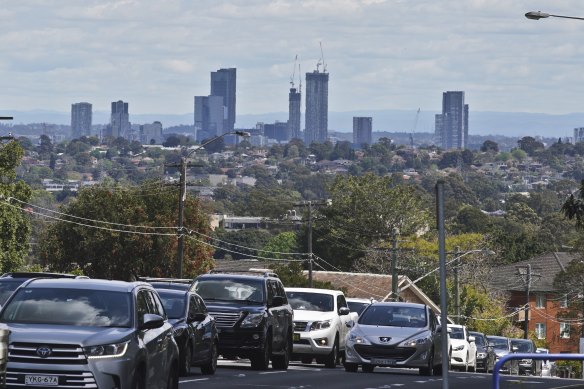This was published 5 months ago
Suburbs where apartment values are cheaper than their peak
Unit values are languishing below their peaks in a string of Sydney and Melbourne suburbs, often where there has been significant new apartment development.
An investor-driven boom during the 2010s has created a glut of homes that are less suitable for long-term owner-occupiers, who are not bidding up prices even in a housing crisis.

Unit values are below their peak in several suburbs.Credit: Ben Rushton
There are 65 unit markets in Sydney and Melbourne where values are below their record highs from last decade, new analysis from property researchers CoreLogic found. In some, there are vendors selling at a loss.
In Sydney’s Epping, the median unit value is 18.4 per cent below the peak it reached in May 2017. The median unit value has also slumped in Sydney Olympic Park, down 14.8 per cent, and home to Opal Tower, which was evacuated due to cracking on Christmas Eve 2018 before structural repairs were completed.
The Melbourne CBD is 8.4 per cent lower than its May 2017 peak, while Southbank (-4.2 per cent) and Docklands (-5.1 per cent) are also lower. The biggest drop in Melbourne was East Melbourne, although there the completion of luxury apartments at The Eastbourne previously pushed up the median value.
CoreLogic head of Australian research Eliza Owen said many units were developed for investor buyers during the off-the-plan apartment boom and were not desirable for owner-occupiers.
The share of new housing finance to investors hit a record 46 per cent in 2015, then dropped sharply after the bank regulator clamped down on property investment lending last decade, and fell below 25 per cent once the pandemic began. This led to a unit construction boom last decade, she said, when apartment approvals peaked at 123,000 in the year to August 2016.
“There is a lot of supply of relatively cheap property in Sydney and Melbourne; the problem is they don’t meet the needs of today’s buyers because they were developed for a very particular buyer at a particular point in time,” she said.
“It became pretty clear as that cycle matured that the homes weren’t even good enough for people to live in – in the extreme cases, an Opal Tower.”
She said the new supply did bring rents down but was often smaller apartments near universities or the city centres.
“They stand as kind of a waste, unfortunately, in some of our most precious, convenient sites in Sydney and Melbourne in the middle of a housing crisis,” Owen said.
She said there are lessons as governments aim to increase the supply of new homes.
“Viewing housing solely through the lens of wealth creation can be a detriment to the quality of life for people that are living in it, and lead to a lack of utilisation of this housing,” she said.
“The right kind of supply is large enough for different kinds of households to want to live in it long term, whether that’s a wealthy Boomer who’s downsizing or a young family who is looking for sufficient bedrooms and outdoor space to raise a family.”
Residential property expert Angie Zigomanis said new apartments command a premium because they are new, but also because they have depreciation benefits, and tend to show worse price performance the first time they sell after their initial off-the-plan purchase.
“Domestic investors are still below where they were in 2017, 2018 … there’s a lot fewer overseas investors, who were probably contributing part of that demand as well,” the head of data and insights at Quantify Strategic Insights said.
He said potential investor buyers now are pragmatic about how much they can charge in rent compared to their higher mortgage repayments.
Many of the units are small and have less-than-ideal layouts, such as borrowed lights to bedrooms, bedrooms that open into the lounge room instead of a hallway, or no balconies, he said.
“To build those more desirable apartments is going to cost you more money – they’re going to be bigger, they’re probably not as efficient in terms of trying to pack as many apartments as you can into the same site. So I suppose that’s where the challenge is, in terms of being able to do it in a way that’s still affordable,” he said.
Buyer’s agent Rich Harvey, chief executive of Propertybuyer.com.au, said units can still be a great investment – particularly in an area with limited ability for rezoning, since higher supply puts downward pressure on prices – and if they have features such as an art deco style, balconies, internal laundries, and access to transport and amenities.
“I still think that’s a great idea for the state government to do higher rezoning around transport nodes,” he said.

Investors find it harder to access finance now.Credit: Ben Rushton
“[But] the design of those units needs to be paramount.”
He would like to see a design competition, spacious floor plans, study nooks, natural light and cross ventilation.